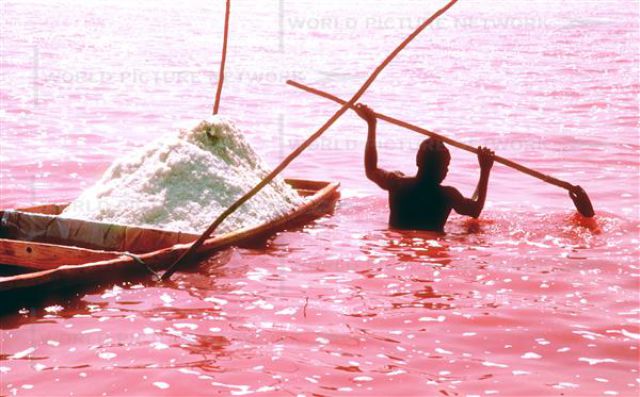 Not all salt harvesters are held in equal esteem. As in many economically-challenged zones across the world, outside Dakar, in the shallow basin of Senegal’s Lac Rose, salt workers labour under the unrelenting heat of the dry-season sun, earning a pittance compared to the sums received by the package-marketers of the salt they produce. Children of salt-making families receive little schooling, beginning their work in the salt fields as soon as they are old enough to carry baskets without falling and dropping the precious crystals. Women, mothers, sisters, wives, often labour as long and diligently as the men, but are paid a smaller wage, points out Michele, talking about the hardships and hospitality of the salt workers. A Different Truths exclusive for the Special Issue on Africa.
Not all salt harvesters are held in equal esteem. As in many economically-challenged zones across the world, outside Dakar, in the shallow basin of Senegal’s Lac Rose, salt workers labour under the unrelenting heat of the dry-season sun, earning a pittance compared to the sums received by the package-marketers of the salt they produce. Children of salt-making families receive little schooling, beginning their work in the salt fields as soon as they are old enough to carry baskets without falling and dropping the precious crystals. Women, mothers, sisters, wives, often labour as long and diligently as the men, but are paid a smaller wage, points out Michele, talking about the hardships and hospitality of the salt workers. A Different Truths exclusive for the Special Issue on Africa.
Along the coast of Senegal, in the dry season, seagulls circle and wheel over the fine beige sand of the beach, crying discontent in the hot still air as the sun bids farewell to the sky. Huge flocks, hundreds of birds, fly back from the busy-ness of their day, to roost in big trees, under eaves, in the draft-spaces between ceiling and roof—any space that was accessible, and, for the most part, safe. Streaming out as birds crowd in, chattering their hunger, and peeping eco-location to avoid collisions, hundreds, thousands of bats flap out to eat their fill of insects, though some, it is true, seek the sweetness of fruits wherever they can find them.
In its long descent towards evening, the setting sun graciously allows the cool mists that form offshore to caress the beaches once again. It is a happy time, a scene replayed every fair-weather dawn and twilight — filled with the sound of wings, the invigorating scent of the salt-tinged air, and the ubiquitous songs of the muezzin, calling local flocks to prayer, amplified by loud speakers affixed to the tall turrets of the mosques. And, if you look, scattered everywhere around the grounds of mosques, the back sides of settlements, along less-traveled beaches, are charcoal-grey or yellow, pockmarked rocks, some small enough to fit in the hand, some huge as boulders, all seeming light as feathers, pumice left from an earlier age.
The waters of the Atlantic have flowed since before volcanoes unleashed their magma into great red streams along these shores, ages ago. Inside the reefs which protect the sandy beaches the waves are peaceful, but offshore, out in the cold, deep and ceaseless currents, a day spent on the swelling tides can bring perspective to a person, returning heart and mind to synchronicity with the slow, majestic march of the vast ocean of the heavens. Far behind, thin strips of beach lie, quiet, almost out of sight — landing-fields where the fishermen return, daily, to earth. It is a slow repatriation, surrounded by the scents and sounds of the sea, arms straining to pilot the fantastically-painted boats, their hulls filled with the catch of the day.
In the late afternoons, as the fishermen return home, they berth their resplendent fishing boats side by side along the beach and mud-flats of ocean and of river. Hauling the day’s catch onshore to sell along long rows of wood-and-crate tables, covered with plastic or cloth, or even just newsprint, the fishermen gather with their round-cheeked mothers, sisters and wives. Busy housewives, eager to shop for dinner, men wanting to exchange talk of the day, fisher folk and passersby, all converge on the quickly-assembled marketplace, looking to quench thirst for talk, to slake hunger for the things of land. They jostle and rub elbows, to snack on nems (spring rolls) or small, salt-grilled fish, or merely to sniff appreciatively, and wait for the evening meal’s more complex dishes — often concocted with freshly-ground peanuts, vegetables and yams, chili and spices, slathered on baguettes, or served with rice or sometimes couscous, treasures of cuisine engrained in the culture and tempo of the place.
Further inland, on the roadways just beyond the beaches, old vans, new vans, metal bodies mounted on modified motorbikes, and all sorts of mass-transit conveyances are painted as fantastically as the boats, and vie with one another to carry the throngs of locals and tourists and all of their baggage, their groceries, their goats and chickens and bicycles, and all, to other destinations. These ‘cars rapides’ may or may not be visible much longer, as Senegal upgrades to new Indian- and Chinese- made (instead of the nearly-ubiquitous aging Renault) buses, though it will be a shame to lose the flavor of local artistry the buses provide, with their brightly-painted eyes, trees, birds, animals, slogans, destination-names, pictures of Sufi-Muslim leaders, poets, and people of note (including rock-icons like Madonna).
Taxies of various age and repute imperiously demand right-of-passage with their horns, and spry-footed officials direct crowds, vehicles, and even onlookers with waving arms, batons, and shrill blasts of their  whistles, to help guide the bustling hordes through the Gordian Knot of rush-hour streets. Sometimes, with great good fortune, there may be an open chair or stool near one of the charcoal-fueled braziers heating water for tea, which can sometimes be ferociously-strong tightly-curled leaves of green (or occasionally black) tea, sometimes the refreshing balm of mint, and most times a combination of the two, almost always sweetened with sugar. The brewing tea is poured into a cup and returned to the pot several times to mix it, and, when finally ready to serve, poured from on high, to aerate the infusion, with a flourish meant to add to the anticipation of those about to drink. Poured into small glazed cups or short, clear glasses, nary a drop is spilled, though the tea seems to spout into the cup from an impossible distance, because, according to local connoisseurs, the thicker the foam from the height of the repeated pourings, the better the tea will taste.
whistles, to help guide the bustling hordes through the Gordian Knot of rush-hour streets. Sometimes, with great good fortune, there may be an open chair or stool near one of the charcoal-fueled braziers heating water for tea, which can sometimes be ferociously-strong tightly-curled leaves of green (or occasionally black) tea, sometimes the refreshing balm of mint, and most times a combination of the two, almost always sweetened with sugar. The brewing tea is poured into a cup and returned to the pot several times to mix it, and, when finally ready to serve, poured from on high, to aerate the infusion, with a flourish meant to add to the anticipation of those about to drink. Poured into small glazed cups or short, clear glasses, nary a drop is spilled, though the tea seems to spout into the cup from an impossible distance, because, according to local connoisseurs, the thicker the foam from the height of the repeated pourings, the better the tea will taste.
As in so many nations, when drinking tea (or coffee), it is good to first appreciate the warmth of the cup by encircling the vessel with the hands, and, next, to enjoy the curl and aroma of the tea-scented steam, so refreshing after a long day, before tasting the tea itself. The tea is savored mornings, after meals, when greeting friends or visitors, but, always, and especially, as the long day winds down, and energy flags before nightfall.
And in the kitchens of homes and restaurants, sitting on stools around food stalls or somewhere out in ramshackle homesteads constructed where the landless find some small corner of space to hold on to, everyone settles down, and the salt is set out, carefully, in preparation for eating the evening meal.
Salt… so simple a crystal, so central to flavor, so necessary to the lives of humans and animals alike. Marsh plants and mangroves cannot exist without salt, and, certainly, the halophilic algae, fungi and shrimp which turn world-famous saline lakes rosy and give flamingoes their pink hue, could not live without it.
Like so many nations in the world, Senegal has its salt flats, where workers stand in collecting basins and use long-handled wooden rakes to push water, pull salts, and hasten the evaporation process. In Japan, some salt-makers speed the process by boiling the increasingly saline waters until salt crystals form. In France, America and other nations, artisanal sauniers eschew coarser bottom-precipitated salts, and regulate the flow of waters into the brine pools, facilitating the production and harvest of fleur de sel (salt flowers, delicate crystals gathered from the surfaces of briny waters, accounting for unique moisture content and terroir — the locale-dependent “fingerprint” of taste). Of course, not only “new” salt is valued and sought. Elsewhere in Africa and around the world, mountainous regions and deserts harvest ancient, deep mines of salts, sometimes carried out in huge, other-worldly crystals. Everywhere, salt is an integral part of our tables, of our lives.
But not all salt harvesters are held in equal esteem. As in many economically-challenged zones across the world, outside Dakar, in the shallow basin of Senegal’s Lac Rose, salt workers labour under the unrelenting heat of the dry-season sun, earning a pittance compared to the sums received by the package-marketers of the salt they produce. Children of salt-making families receive little schooling, beginning their work in the salt fields as soon as they are old enough to carry baskets without falling and dropping the precious crystals. Women, mothers, sisters, wives, often labour as long and diligently as the men, but are paid a smaller wage, even in this “modern age” of internet-fostered gender awareness.
Lac Rose, or Lake Retba, as it is also known, used to be home to rich fishing grounds as well as for salt-harvesting. But the economic pressures of the last half-century have changed all that. Water flow has been limited, and now Lac Rose has a salt content is as high as that of the Dead Sea, topping 40% salinity in some sections. Even so, fleur de sel is not gathered here; salt harvesters stand, chest-deep in the pink waters, raking the less-valued crystals that collect on the salt-basin’s floor, gathering them into baskets by hand. They coat their hands and bodies with shea butter (another local product) to protect themselves from damage from the extreme salinity. In other salt-fields, other nations, worker’s hands and feet become so saturated that, even after death, their bodies cannot shed the concentrations of salt.
It is hard, back-breaking labor, in the salty waters and onshore. Yet people come from Mali, from Guinea, from Burkina Faso, Guinea-Bissau, the Côte d’Ivoire, from many nations, to harvest salt in the dry hot season, because to find work at all, in the less-seen backwaters of unskilled labour pools, is still of utmost importance.
Despite the hardships, in the mid-day heat, as they rake, dry, and trade the salt, the workers talk. They listen to radio or YouTube, they sing, sometimes. They open up their ranks, occasionally, and welcome the adventurous outsider who comes for a day, or a week, to live with them, to see what it is like to harvest Lac Rose salt, to learn their stories.
 And, at night, they cook. While most of the salt they gather is sold, every one saves a little bit, for their own tables, for the tables of their families, their mothers, their grandmothers, back in whatever settlement or state or nation they call home. For people who, generation upon generation, used to be salt harvesters on Lac Rose, the incomparable taste of salt harvested there (even back when fishing in the waters was still possible) cannot be found anywhere else. And for this they will brave broiling temperatures in the day, and withstand drops to near-freezing during the wind-swept nights.
And, at night, they cook. While most of the salt they gather is sold, every one saves a little bit, for their own tables, for the tables of their families, their mothers, their grandmothers, back in whatever settlement or state or nation they call home. For people who, generation upon generation, used to be salt harvesters on Lac Rose, the incomparable taste of salt harvested there (even back when fishing in the waters was still possible) cannot be found anywhere else. And for this they will brave broiling temperatures in the day, and withstand drops to near-freezing during the wind-swept nights.
As twilight’s stars find mirrors in the mountains of salt crystals slowly drying onshore, fine grains of salt are sprinkled over the evening’s meal, and one of the finest traditions of Senegal, that of teranga (the word for hospitality in the Wolof tongue), shines forth. It is good to bring some tightly-curled leaves of gunpowder green tea, some fresh mint, perhaps, and some sugar; it is good to share rice, or couscous, or whatever else you might carry to gift your hosts if you visit.
But it is most important to bring an open heart and a ready smile, because generosity knows no specific demographic, and is not limited to the sidewalk cafes, the restaurants, or even the fine homes of more urban people. Hospitality, in its truest form, consists of sharing what there is, and is offered to family, to friends, and to visitors alike. There is much that we, as humans, should, and must, change in how we live and interact upon and with this world, but enduring change happens only one step at a time.
In the present, to share what you have so all have enough at a meal, seems a very good beginning. But perhaps the most important value of teranga — as people across so many cultures, through so many centuries of life have learned — is in how each one treats the other. And in some way, salt, and tea, and teranga, all remind us of this; in some way, each contributes their small part to that elusive quality of love…
©Michele Baron
Photos from the Internet
#Salt #SaltOfAfrica #Senegal #LacRose #SaltWorkers #Africa #SpecialFeature #Teranga #DifferentTruths






 By
By
 By
By
 By
By